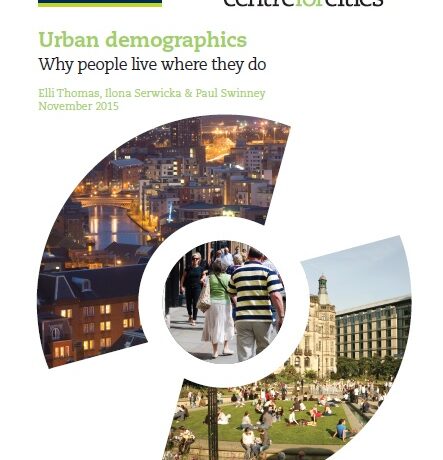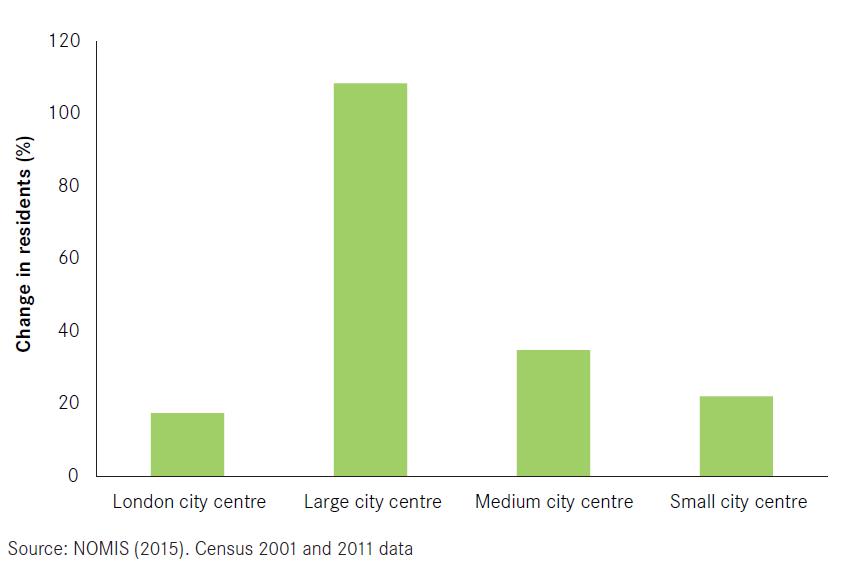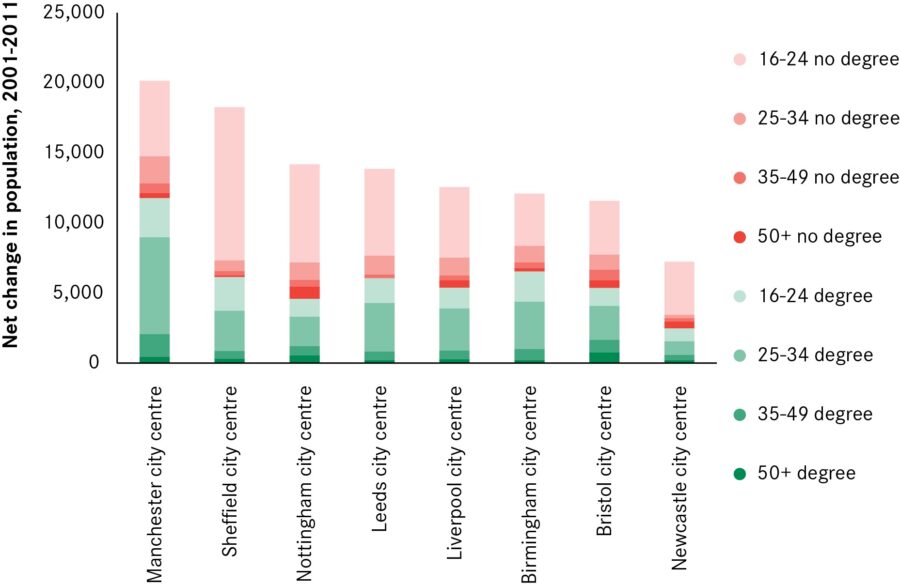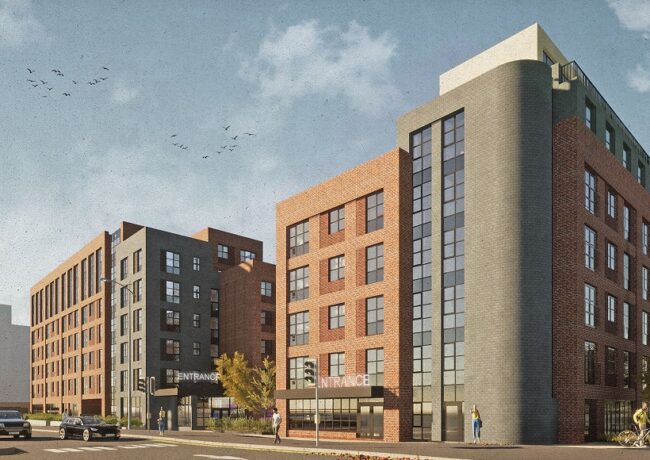The return of city centre living in Manchester
City centre living has made a comeback. After decades of people quitting the centre of cities for the sanctuary of suburbs and more rural areas, this pattern has reversed.
Between 2001 and 2011, the number of people living in city centres increased by 37%, compared to 8% and 6% in suburbs and hinterlands of cities respectively.
But this return to city centre living wasn’t seen everywhere – as the chart below shows, it was principally led by our large cities.
And it was driven by young professionals and students – of all the people who moved to the city centres of large cities between 2001 and 2011, around half had a degree, with the majority of the rest studying for one.
Manchester was at the forefront of this growth. In the decade to 2011, its city centre residents increased by 20,000 – growth of 83% (see chart below). This was matched by a boom in apartment building – around 7,000 new homes were sold in the city centre during this time.
The demographic of the people moving into Manchester city centre tells us something interesting about the return to urban living more generally, and why it has been much stronger in some cities than in others.
Manchester’s growth was mainly driven by young professionals. Of all the residents moving into Manchester city centre in the decade to 2011, nearly 60% had a degree, the majority of which were aged under 35.
This has come at a time when Manchester’s city centre economy has also seen a resurgence. Between 1998 and 2011, the city centre saw growth in private sector jobs of 44% – the second fastest growth seen in any city centre. And this was driven by knowledge-based services jobs, which tend to be high paid and high skilled. They accounted for three quarters of this growth.
This strong growth of the city centre economy has vastly improved its appeal as a place to live. So it is no surprise that in the survey work we conducted as part of our research, residents of Manchester city centre listed access to work as one of the key benefits of living where they do.
Not every city centre offers this benefit. While Manchester and other large city centres have seen strong private sector jobs growth, many medium and small sized cities have seen their centres contract. And this has weakened the attractiveness of their city centres as places to live – why choose to live in a flat and commute out of town, when you can live in a house with a garage and garden in the suburbs instead? It’s the same reason why Sheffield’s city centre residential growth – while large – was driven by students. It has been the only city to see a decline in its city centre economy in recent years, with the result being that it has been much less attractive to young professionals than central Manchester.
As the UK continues to specialise in more knowledge-based services jobs, the city centre locations that they prefer will play an ever larger role in the national economy. And so it’s likely that Manchester city centre will continue to be the engine room of the wider city economy in the coming years as it has done in the recent past.
This has two big implications for policy. The first is that as the economy increasingly concentrates in one small part of the city, commuting by car will become ever less practical. In central London, home to 1.4 million jobs in 2011, 90% of workers commuted either by public transport, by foot or by bike. And so to support the continued growth of the Manchester city centre economy, continued improvements will need to be made to public transport to both get people into work each day and widen the net of people that city centre employers can hire from.
The second relates to decisions on how space is used across a city. People value amenities differently at different stages of their lives, and this means that they choose to live in different parts of a city – be that the city centre, the suburbs or the fringes of a city, depending on their time of life. This means that the geography that planning decisions are taken should stretch across a city, rather than individual local authorities. Meanwhile, planners will also need to balance the competing demands for residential and commercial space within the city centre. The introduction of Permitted Development Rights under the last parliament potentially skews planning law in favour of residential development, which may start restrict the supply of commercial space if Manchester’s city centre economy continues recent strong growth.
Manchester city centre has gone through a rebirth, both in terms of its economy and its attractiveness as a place to live. And as the city as a whole continues its revival, the role that its centre plays will become ever more important. The challenge for Greater Manchester policy makers will be to continue to improve public transport links and balance commercial and residential demand for city centre space to support the city centre’s future growth.








I am a retired professional who does not want to ‘downsize’ but would like to live in the city centre. All the houses being built there are no bigger than corridors and the flats are too small. What happened to square, decent-sized rooms and where is the provision for older people?
By Tony Heyes
Good to see our two big cities enjoying growth at their core. What are the actual populations for each City centre in Liverpool and Manchester?
By Man on bicycle
I agree with Tony Heyes.The houses are all apt to be in grotty areas too,with a lot of social problems.Why are lovely areas near to the city centre,with nice housing,like Fallowfield and Victoria Park allowed to be student ghettoes? Surely these places should now be regenerated for professionals with children and not just litter strewn streets,full of tatty rented properties.You would not get areas like this so close to Central London. Victoria Park has houses,which wouldn’t shame Kensington,yet it is full of overflowing bins and people who care not a jot about it,because it is not their home.
By Elephant
City Residential puts the population of Liverpool city centre at 37,297, however if you include the docks the population would be 43,880. For comparison, the population of the city centre was 2,300 in 1991.
By Daniel
How long till the ‘Liverpool is better than Manchester despite all the evidence’ comments arrive? I love ’em
By i leave comments on place north west
Elephant – You will be glad to hear that Fallowfield is now subject to a number of HMO regulations which makes it nigh on impossible for investors to get a license if they buy a house (They can renew if they already own the property). This measure has been taken in order to create a better mix of residents.
By SC
All evidence is open to interpretation.
To “I leave comments…” – It seems for most people who prefer Liverpool, it is more a matter of the cultural elements, atmosphere, hertitage, culture, architecture, etc., which is much more difficult to quantify than e.g. office occupancy, population growth. Manchester is doing well economically; that doesn’t mean its a nice place to live. Leave people to their opinion.
By dreamer
69 minutes
By i leave comments on place north west
Elephant, London has a very different history to Manchester, comparing the two is pointless. The areas outside of Manchester city centre are what is known as the inner city, and as is case of most cities in the world these are the poorer areas, smaller housing and a large immigrant population.
By Hives
I didn’t say Liverpool is “better”, I said Manchester isn’t (as) nice to live in. Lots of people clearly think Manchester is “better” because of the job prospects and that is perfectly valid too.
By dreamer
More Centre for Cities pap.
Liverpool, twinned with Tardis.
Liverpool city centre population was already around 20k in 2007. Today it’s well over double that.
By Mike
@Daniel, yes just saw your comment. Spot on. And who is likely to know Liverpool better? Someone in London equipped with google maps and ONS stats? Or someone on the ground in the city, actually selling and renting out properties over a prolonged period of time and in contact with the city authorities? I know which I’d sooner pick to listen to.
By Mike
I attended a seminar in around 2010 a chap from Isis Developments. Obviously an unfortunate name now but that’s a side issue. He said that city centres to succeed as places to live needed to have the family apartments and houses. And homes for people who aren’t just young professionals who will stay in their city centre apartment until they have children and then are forced to move out to the suburbs as city centre living just does not suit the family lifestyles. Doctors, dentists, schools were needed. And although he spoke re Manchester having not enough ‘services’ for city centre dwellers. These were common requirements for all city centre living. I also attended the Vancouver project where the architect spoke about why Vancouver is considered one of the best places to live. But sadly both Liverpool and Manchester developments seem to just be the usual pile em in sell em on with no consideration. So don’t the city councils need to say erm stop, were gonna put these restrictions on? As were gonna make it work like the European cities do?I completely agree re Tony Heyes comment not all people who want to live in the city centre are young professionals.
By Mary Smiley
I’m afraid you’ve caught me – I was trying to provoke some of the more reactionary and parochially minded comments I’m seem to see on this site. You ruined my fun with a entirely reasonable answer.
By Anonymous
Glad to hear that they are doing something to salvage Fallowfield.With Plattfields nearby,it could be a beautiful area,to rival Didsbury.
By Elephant
Interesting article and we need more people living in city centres but Liverpools city centre population is over 36k so the stats person needs to check their facts before publishing.
By northwester
Facilities for families growing in Liverpool centre too. New primary school at LIPA. That will be three primary schools in city centre. New sixth-form college from next year also at LIPA. And it’s not true that all city centre space is small. Wapping Quay has huge living rooms and double height brick-vaulted ceilings; similar the other old dock conversions like Albert and Waterloo. Stanley should provide similar space when the conversion is complete albeit a bit further along the waterfront.
By Altmouth L38